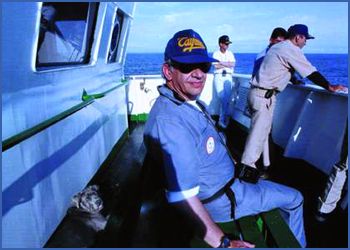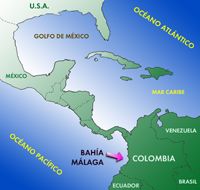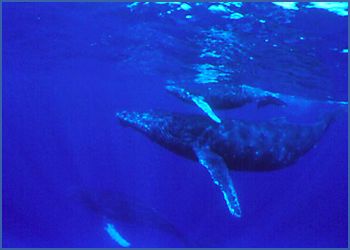

HomeAbout ColombiaNewsPeopleScenic ViewsLinksAuthor



Welcome to the world of humpback whales and their hearts and songs.
A Colombian scientist, Dr. Jorge Reynolds, uses a naval submarine to record on tape the heart beats of humpback whales in their ocean environment. Dr. Jorge Reynolds' hope is to be able to understand the physiological misteries of the whale's heart since eventually it could provide a light about treatment of some diseases that affect human race.
 In search for a giant heart beat
In search for a giant heart beat
Dr. Reynolds has worked in electronics and medicine particularly in cardiology. In 1958, he helped design one of the first pacemakers in the world. After that he studied the reactions of hearts in all kinds of sports. Also He worked on high-altitude Himalayan expeditions to Manaslu and Everest. He began to record animals as a way to understanding the evolution of the heart. He went after whales because they are the biggest animals, and the biggest whales have the biggest hearts that the world has ever known. For example, the blue whale is three times bigger than the biggest dinosaur.
 Dr. Jorge Reynolds, the "King of hearts", has cruised around Gorgona Island off the coast of
Colombia in a naval submarine. His mission: to get close enough to migrating pods of humpback
whales to hear their hearts beat. Over the past 15 years Reynolds, a Cambridge-trained
electrical engineer, has built up what he claims is the world's most extensive collection of
heartbeat recordings--an archive of 300 different animals, from mosquitoes to elephants. But
his true love is the whale. The American, Russian and Colombian navies have all helped him
pursue his passion, and thanks to them and their sonar systems he now has more than 200 hours
of whale heart beats captured on tape.
Dr. Jorge Reynolds, the "King of hearts", has cruised around Gorgona Island off the coast of
Colombia in a naval submarine. His mission: to get close enough to migrating pods of humpback
whales to hear their hearts beat. Over the past 15 years Reynolds, a Cambridge-trained
electrical engineer, has built up what he claims is the world's most extensive collection of
heartbeat recordings--an archive of 300 different animals, from mosquitoes to elephants. But
his true love is the whale. The American, Russian and Colombian navies have all helped him
pursue his passion, and thanks to them and their sonar systems he now has more than 200 hours
of whale heart beats captured on tape.
 "Sometimes you can hear the the whales' calls or heartbeats inside the submarine
without a microphone. When a whale is very close to the submarine, all you can hear is the
sound of it singing. But if you have a practised ear, like a cardiologist, then, yes, you could
hear the difference between the singing and the heartbeats.", Dr. Renolds says.
"Sometimes you can hear the the whales' calls or heartbeats inside the submarine
without a microphone. When a whale is very close to the submarine, all you can hear is the
sound of it singing. But if you have a practised ear, like a cardiologist, then, yes, you could
hear the difference between the singing and the heartbeats.", Dr. Renolds says.
Did you know that one of the main interests is to understand the arrhythmias of the human heart which can be a warning sign of heart disease. By comparing human and whale hearts, we have already learnt a few things we didn't know before. And all thanks to Dr. Reynolds research.
For example, the heart of the whale moves in a similar way to a human heart, but the electrical system is probably different. Since the whale heart is so much bigger, the electrical signals that make it contract must travel faster to reach the entire muscle in time. It's more like the human nervous system, where the conduction is more rapid than in the heart.
A whale's heartbeat is much slower and deeper than a human heartbeat. A whale has about five to six beats per minute at the surface. When it dives 100 metres down the heart frequency is reduced to about half that, maybe three beats per minute to save oxygen and reduce the perfusion of the blood in the superficial organs.

 |
HOME: NICE LOOK OF COLOMBIA |  |
 |
 |
| Drop us a line! |